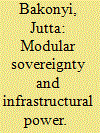|
|
|
Sort Order |
|
|
|
Items / Page
|
|
|
|
|
|
|
| Srl | Item |
| 1 |
ID:
111359


|
|
|
|
|
| Publication |
2012.
|
| Summary/Abstract |
Electric drive vehicle technologies are being considered as possible solutions to mitigate environmental problems and fossil fuels dependence. Several studies have used life cycle analysis technique, to assess energy use and CO2 emissions, addressing fuels Well-to-Wheel life cycle or vehicle's materials Cradle-to-Grave. However, none has considered the required infrastructures for fuel supply. This study presents a methodology to evaluate energy use and CO2 emissions from construction, maintenance and decommissioning of support infrastructures for electricity and fossil fuel supply of vehicles applied to Portugal case study. Using Global Warming Potential and Cumulative Energy Demand, three light-duty vehicle technologies were considered: Gasoline, Diesel and Electric. For fossil fuels, the extraction well, platform, refinery and refuelling stations were considered. For the Electric Vehicle, the Portuguese 2010 electric mix, grid and the foreseen charging point's network were studied. Obtained values were 0.6-1.5 gCO2eq/km and 0.03-0.07 MJeq/km for gasoline, 0.6-1.6 gCO2eq/km and 0.02-0.06 MJeq/km for diesel, 3.7-8.5 gCO2eq/km and 0.06-0.17 MJeq/km for EV. Monte Carlo technique was used for uncertainty analysis. We concluded that EV supply infrastructures are more carbon and energetic intensive. Contribution in overall vehicle LCA does not exceed 8%.
|
|
|
|
|
|
|
|
|
|
|
|
|
|
|
|
| 2 |
ID:
185638


|
|
|
|
|
| Summary/Abstract |
This article uses the example of the Mogadishu International Airport zone and takes a spatio-temporal lens to explore how (sovereign) power unfolds in international interventions that aim at building a sovereign state. I show that the Mogadishu International Airport zone emerges as an elastic frontier zone that contradicts the sovereign imaginary intervenors aim to project and undermines many of the taken-for-granted boundaries that states tend to produce. The Mogadishu International Airport and similar zones emphasize the centrality of logistics and circulation in interventions, but also point towards their temporal and liminal character. Modularity became the material answer to the demand to secure circulation while adapting to the rapid rhythm and short timeframes of statebuilding. Modular designs enable the constant adaptation of the intervention terrain, allow intervenors to deny their power and imprint and facilitate the commercialization of supply chains and intervention materials. Sovereign power that operates through such zones becomes modular itself. It is exercised as an adaptable, in parts exchangeable, and highly mobile form of power that operates through crises and emergencies. The spaces and materials created by modular forms of sovereign power remain elusive, but nonetheless stratify experiences of power and security.
|
|
|
|
|
|
|
|
|
|
|
|
|
|
|
|
| 3 |
ID:
105732


|
|
|
|
|
| Publication |
2011.
|
| Summary/Abstract |
This paper examines the economic analysis (social cost-benefit analysis) underlying two decisions to build an interconnector (NorNed and the East-West interconnector) in Europe. The main conclusion is that current interconnector and transmission investment decisions in Europe are unlikely to maximize social welfare. The arguments are as follows. (i) It is unclear how much demand for transmission capacity and interconnectors actually exists, and thus the benefits of investment are unclear. (ii) Both analyses underlying the investments studied are incorrect, to the point where, in one case, even the sign may be wrong. (iii) The main criticism concerns the fact that they do not take the resulting changes in generator investment plans into account and ignore the (potential) benefits of increased competition. (iv) Several smaller issues can be improved, such as the discount rate used. (v) Decisions at the European level are taken very differently, and approval may depend on which authority grants approval. (vi) Interconnector decisions receive the most attention, although most money goes to transmission investments. Two research recommendations for future improvements are formulated.
|
|
|
|
|
|
|
|
|
|
|
|
|
|
|
|
|
|
|
|
|